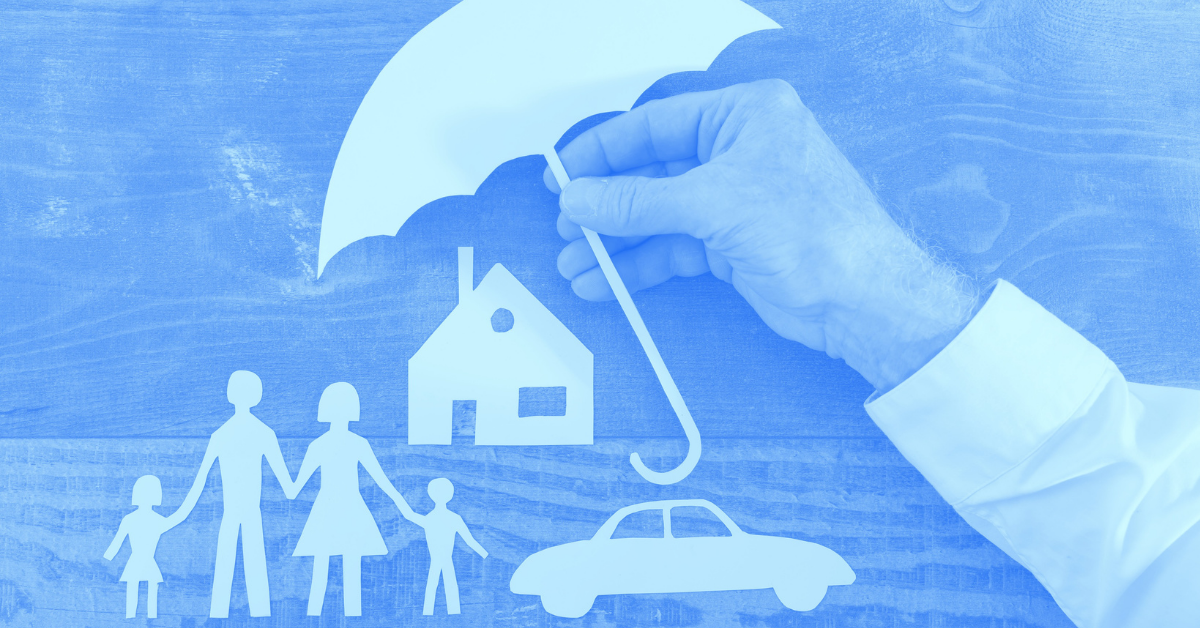Disability Insurance: Use This Process to Help Determine What You Need (and What You Don’t)
Share this
.png?width=554&name=BLOG%20IMAGES%20TEMPLATE%20(26).png)
8.0 MIN READ
The good news is we can prepare for this in practical terms by getting the proper insurance coverage, or knowing how to self-insure against things going sideways.
The two things most people want to protect are:
- Their ability to earn an income, through disability insurance
- Their financial dependents, through life insurance
The reason for both of these things is to provide protection for your cash flow and your assets.
We need to protect these things because they’re what enable you to have the lifestyle you want, and achieve your goals in both the short- and long-term.
Is There a Point to Buying a Product You Hope You’ll Never Use?
Before we go on, it’s gotta be said: we don’t particularly like insurance. That’s for a few reasons.
For one, it’s a product you purchase (and it’s often expensive) that you hope you never have to use.
If you’re using your disability insurance, you’re probably ill or injured and unable to work. (And if you’re using your life insurance… well, you probably aren’t using it because you’re no longer with us. Not an ideal outcome.)
So why cover this? Can’t we all just do without?
Not really. Most of us need some degree of coverage from the right insurance policies.
But that brings me to another reason I’m not a huge fan of insurance: it’s not easy to get the best coverage for you because insurance is sold through brokers who earn commissions on what they sell.
That doesn’t mean people who sell these products are bad people. But there is an inherent conflict of interest, because the bigger and more expensive the policy, the more the insurance broker stands to make.
Historically, it’s been tough for consumers to get the right information to determine for themselves how much insurance is sufficient… and how much might be overkill and unnecessary.
This is part of the reason it’s important to cover this as part of a financial planning process: you should be educated on how insurance is sold and get an independent evaluation of what you need (versus what you don’t) from someone who doesn’t stand to make a cent from whatever choice you make.
When you better understand why disability insurance is important, you can make more informed choices about what kind and how much you need — and not worry about being oversold something that isn’t the absolute best fit for you and your situation.
Why Disability Insurance Matters
We’ve talked about life insurance before on this blog — but we haven’t spent a lot of time looking at disability insurance.
And we should! While it might sound extremely boring and maybe even irrelevant, we need to talk about it and ensure you know how to get the coverage you need.
The truth is, almost every young, working adult needs some degree of disability insurance. Here’s why:
Take whatever you earn per year, and then multiply that by 20 or 25 years.
That’s an estimate of how much income you could give up if something happened that prevented you from being able to work and earn your paycheck.
Your income is your biggest asset when you need to earn money, build savings, and establish wealth to fund your life.
Think about it: if something happened to you today and you could no longer earn an income tomorrow (or, no longer work the kind of job that would allow you to earn the same income that you can earn right now)…
How would you pay your living expenses, let alone add to your savings, contribute to long-term investments, and fund your goals?
You’d likely be in big trouble, because its the combination of your income + current savings rate that allows self-made folks to create and build their own wealth.
This is where disability insurance comes in, and why it’s important to have at least some degree of coverage.
How Much Disability Insurance Do You Actually Need?
If you’re working and earning an income, and you need that income to pay your bills and build your savings and investment balances, then you need disability insurance. No question.
What is a question is how much is sufficient, and how much can you “self-insure” on your own.
When you dig into the details, there’s a lot more nuance around determining how much or what kind you need — because there’s no one “right” answer for how much disability insurance you need (or how little disability coverage you can get away with).
These are all the factors you need to consider when thinking through how much, what kind, and where to find the best policy for you.
Short-Term vs. Long-Term Disability Insurance
Short-term disability insurance does what is name implies: it protects you for the short-term.
If you’re unable to work temporarily, the benefit from the policy could pay out to cover a short-term loss of income. Short-term disability will usually pay out immediately, but only covers you for 3 to 6 months.
And this is why most of our clients at BYH don’t need this kind of disability insurance: because they can self-insure thanks to cash reserves.
We already recommend keeping 3 to 6 months’ worth of expenses in cash as an emergency fund, and not being able to work/earn income certainly counts as an emergency.
You can self-insure, too, if you have enough emergency reserves set aside to cover 3 to 6 months’ worth of your regular expenses without an income.
It’s the extended disability through an injury or sickness that could last from now through to your retirement age that would have the biggest impact on your financial life — and therefore, a long-term disability poses the biggest risk to you if it caused you to lose your income for years or permanently.
When we say “most people who work and rely on an income need disability insurance,” it’s really the long-term coverage that we need to think about.
Long-term disability insurance provides you with a replacement to your income for a long time, as in a period of years or even decades. These policies can cover you from now until you’re in your 60s.
They also don’t pay out a benefit immediately even if you file a claim and are approved. Long-term disability insurance policies usually come with elimination periods of a few months, up to a year.
That means, even with this policy in place, you still need an emergency reserve fund to fill the gap between when you file for disability and when you’d actually start receiving your benefits.
A Rule of Thumb for Determining How Much You Need in Coverage, and Where to Get It
A policy that will cover 60% to 70% of your current income provides a good sweet spot to aim for in terms of how much long-term disability insurance coverage you need.
Realistically, insurers won’t cover you for much more than that because they don’t want to incentivize people to become or claim a disability when they could feasibly return to work.
When it comes to taking out a policy, you may already have some coverage offered through your employer as an employee benefit. If not (or if that coverage isn’t sufficient to cover your need), you may need to get a policy from an independent broker.
The pros of getting disability through your employer include the fact that this is usually a much cheaper way to go because you’ll get coverage through a group plan. You also won’t have endless options to choose from, and that can be a good thing because it won’t leave you so overwhelmed.
There are downsides to getting a policy through an employer’s group offer, though. There’s usually a cap in coverage (which may be no big deal if you don’t have a need for a ton of insurance), and your policy will probably be tied to your continued employment with the company.
In other words, if you leave your current company you might also leave your disability policy. Some can be “portable,” meaning you can take over your existing policy yourself and continue paying for coverage — but that will likely be much more expensive than when it was part of the group policy.
There are pros and cons to using an independent broker to purchase your own private (as opposed to group) policy, too. This might be a moot point if your employer offers all the long-term disability insurance you need, but just in case, keep the following in mind if you purchase your own policy:
- You can have more flexibility and choice in coverage, as well as higher coverage amounts available when you purchase your own insurance.
- Insurance you buy on your own isn’t dependent on your employment with a certain company.
- Purchasing private insurance is likely going to be far more expensive than group options you could get through an employee benefit program.
- It can be difficult to get objective advice when determining which policy option is best for you, as insurance brokers usually work on commission and receive more pay for selling more expensive policies.
Working with a fee-only financial planner can be a good way to go if you have no idea how to select the proper policy for your needs.
Your financial planner can sit down and evaluate various options with you to help you understand what makes the most sense and provides you with the best value — and because a fee-only planner doesn’t get paid based on the policy you choose, there’s a little more assurance you’re getting advice in your best interest (rather than just getting sold).
If you don’t have a financial planner right now, you can also simply ask one if they can point you to an insurance broker they trust.
You won’t get the same in-depth analysis if you’re not working with an advisor, but you can at least rest easy knowing you’re going to a trusted contact rather than a random insurance salesperson who may or may not have your best interests in mind.
Questions to Ask to Help Your Determine What You Need for Disability Insurance
Let’s wrap up by looking at specific questions you can ask yourself to hone in on exactly what best serves your needs when it comes to disability insurance.
Here’s what to think through, and ask yourself:
- Knowing how much you need (60-70% of coverage), how much do you currently have? (This could be through previously-purchased private policies, or through employee benefits at your work.)
- What specific circumstances need to be considered here? (I.e., specifics of your cash flow, is your household reliant on income from one spouse more than the other, etc.)
Once you actually have policies in front of you to look at, compare, and choose from, you might also want to ask the following of each policy:
- Is it own occupation or any occupation?
- What is the elimination period?
- What’s the length of benefit?
- Is there a COLA rider? Partial disability option?
- Other features or benefits that should be considered?
Finally, given all of the above, ask: are there gaps in your existing coverage (or would a policy you’re considering still leave a gap in your protection planning)? Or, is the current insurance sufficient?
If there are gaps, what are the potential solutions for covering those? That might look like additional coverage by making adjustments to your benefits with your company at open enrollment or it might mean getting your own private policy.
Hopefully, this can serve as a primer or outline to help guide you through decisions you need to make about disability insurance.
While it’s one of those things we hope we never have to use, it’s likely a critical part of the protection measures to put in place to keep your financial plan on track — and to ensure you can stay financially sound and secure, no matter what may come your way in life.
 About the Author
About the Author
Eric Roberge, CFP®, is the founder of Beyond Your Hammock, a fee-only financial planning firm based in Boston, Massachusetts that specializes in providing planning services and investment management to professionals in their 30s and 40s.
Did you know XYPN advisors provide virtual services? They can work with clients in any state! View Eric's Find an Advisor profile.
Share this
Subscribe by email
You May Also Like
These Related Stories

Good Financial Reads: Disability Insurance

What You Need to Know to Retire Early at 55



